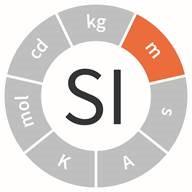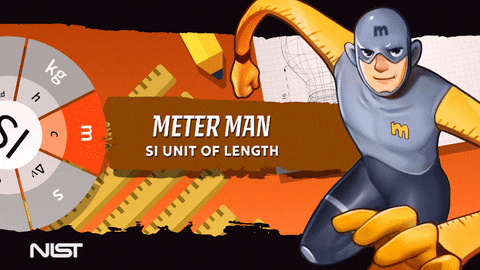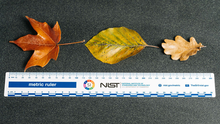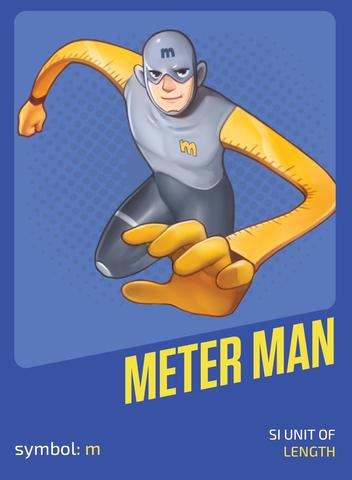SI Units – Length

Resources for Students and Teachers | How do I get a metric ruler? | When did the metric redefinition of the inch occur? | League of SI Superheroes – Meter Man

The meter (m) is defined by taking the fixed numerical value of the speed of light in vacuum c to be 299,792,458 when expressed in the unit m s−1, where the second is defined in terms of ∆νCs.
The meter was once defined by a physical artifact - two marks inscribed on a platinum-iridium bar, like these from the NIST Museum.
From the meter, several other units of measure are derived such as the:
- unit of speed is the meter per second (m/s). The speed of light in vacuum is 299 792 458 meters per second.
- unit of acceleration is the meter per second per second (m/s2).
- unit of area is the square meter (m2).
- unit of volume is the cubic meter (m3). The liter (1 cubic decimeter), although not an SI unit, is accepted for use with the SI and is commonly used when measuring fluid volume, but is also used when measuring gases and solids.
| Units of Length | ||
| 10 millimeters (mm) | = | 1 centimeter (cm) |
| 10 centimeters | = | 1 decimeter (dm) |
| 10 centimeters | = | 100 millimeters |
| 10 decimeters | = | 1 meter (m) |
| 10 decimeters | = | 1000 millimeters |
| 10 meters | = | 1 dekameter (dam) |
| 10 dekameters | = | 1 hectometer (hm) |
| 10 dekameters | = | 100 meters |
| 10 hectometers | = | 1 kilometer (km) |
| 10 hectometers | = | 1000 meters |
Resources for Students and Teachers
Teachers: Top 10 Tips for Teaching the Metric System. (NIST)




FAQ

How do I get a metric ruler?
A metric ruler is a valuable tool for science, technology, engineering, art, and math (STEAM) classrooms. Metric rulers are available from many
retail vendors, which can be identified by using search terms such as "metric rule," "meter stick," or "metric stick." Printable rulers, such as the centimeter Color-square rules, can be color printed on to overhead transparency sheets to make inexpensive metric rulers. The NIST Metric Ruler (SP 376) is available within the NIST SI Teacher Kit, a curated collection of instructional measurement resources.
When did the metric redefinition of the inch occur?
In 1958, a conference of English-speaking nations agreed to unify their standards of length and mass, and define them in terms of metric measures. The American yard was shortened and the imperial yard was lengthened as a result. The new conversion factors were announced in 1959 in Federal Register Notice 59-5442 (June 30, 1959), which states the definition of a standard inch: The value for the inch, derived from the value of the Yard effective July 1, 1959, is exactly equivalent to 25.4 mm.
The conversion factor can be determined:
$$\left.\frac{0.9144\; \mathrm{m}}{1\; \mathrm{yd}}\right|\frac{1\; \mathrm{yd}}{36\; \mathrm{in}} \quad = \quad \frac{0.0254\; \mathrm{m}}{\mathrm{in}}$$
League of SI Superheroes – Meter Man:
This comic book-style video animation series has been developed to help middle school students learn about the 7 SI base measurement units. With his sharp eyes and stretchy ruler arms, no distance is too big or small for Meter Man to measure. A meter is the distance light travels in a tiny fraction of a second.
Navigate to more SI base unit information

EXPLORE THE METRIC PROGRAM
Becoming Familiar with SI | Everyday Estimation | U.S. Metrication | U.S. Metrication FAQs | Prefixes | Metric Kitchen | SI Education and Training | SI Publications | Understanding Metric | Writing with Metric Units | National Metric Week | NEST-R (STEM Registry) | NIST Education Resources
Contacts
-
Metric Program


